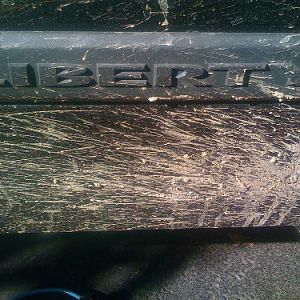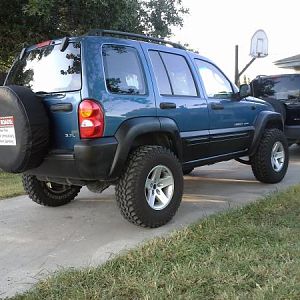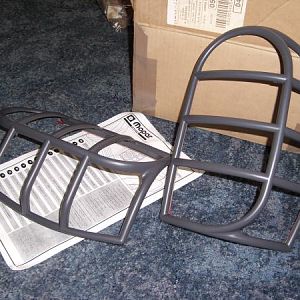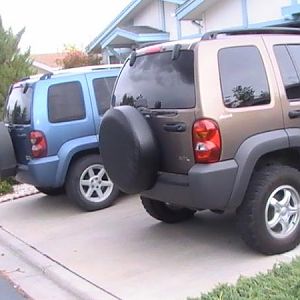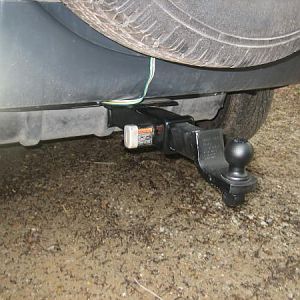Ok, I am a bit confused with my Jeep right now. Now that it has started to warm up here in AZ, it has been necessary to crank up the ac again. However, it will run ice cold for about 10 minutes, then the air is at least as warm as the ambient air temperature for about 5 minutes, then it goes cold again. It is a constant cycle that has been occurring everytime I use it. It just had the refrigerant filled and a discharge line repaired in an attempt to solve the problem. What could be causing this?
You are using an out of date browser. It may not display this or other websites correctly.
You should upgrade or use an alternative browser.
You should upgrade or use an alternative browser.
Air Conditioner Troubles
- Thread starter desertkj
- Start date
Disclaimer: Links on this page pointing to Amazon, eBay and other sites may include affiliate code. If you click them and make a purchase, we may earn a small commission.
Ry' N Jen
Banned
- Joined
- Dec 26, 2006
- Messages
- 9,242
- Reaction score
- 13
The compressor?
Corwyyn
Full Access Member
I'm not a great A/C tech but my guesses would be either A) one of the pressure switches (high or low side) may be going out, or B) possibly some air in the system? Hopefully someone will chime in with a better answer, I need to learn more about the A/C stuff.
sleeve
Full Access Member
Sounds like you are loosing pressure in the system as soon as the compressor disengages which then doesn't allow the two other major components (condensor & evaporater) to do their jobs.
Did you have a leak test done?
Does the system hold pressure?
Did you have a leak test done?
Does the system hold pressure?
JeepJeepster
Full Access Member
Yea, get a vacuum test done and go from there.
Jeepin05
Full Access Member
Just throwing it out there, but could low freon cause this?
Corwyyn
Full Access Member
It might, but he mentioned that he got it topped off. Of course if there is a leak in the system and it's getting low again it would be something to consider.Just throwing it out there, but could low freon cause this?
tjkj2002
Full Access Member
- Joined
- Dec 17, 2006
- Messages
- 10,612
- Reaction score
- 41
If you have a leak in the A/C system it would not blow cold,then warn,then back to cold.I'd be looking at at the temp sensor near the evaporator or a possible compressor starting to fail and/or clutch.
JeepJeepster
Full Access Member
Yea, thats what I was thinking. Usually if its low on freon it wont stay engaged long enough to do anything.
If you have a leak in the A/C system it would not blow cold,then warn,then back to cold.I'd be looking at at the temp sensor near the evaporator or a possible compressor starting to fail and/or clutch.
That's what I've been hearing. 2003KJ also suggested that it could simply be overfilled and causing the Hi/Lo pressure valves which Corwyyn mentioned to be tripping. It's going in tomorrow. I would have a friend help me fix it, but we've already given money to the dealership weeks ago to fix it, so we are going to make them do it. I wanted to get potential causes before I took it in to make sure I did not get taken for a ride though. I'll also post up what the cause was for future reference.
Well, dealership had it overnight. Replaced a "fan clutch", said it was fixed, and the problem continues, so back it goes, and it's getting unfriendly......
Hate when the stealership does't do the job right..or any shop for that matter. Good Luck, keep us posted.
Desert.......They should be able to diagnose that thing......especially where you are in the desert.......geeezzzzz. They must do a/c stuff there all year since no one there can live without it. You would think they should be real good at a/c systems in Az for cryin-out-loud.
The most common thing would be a refrigerant leak (that r-12 stuff). They should recharge the system and put a dye in the system and then check it with a black-lite pen or whatever you call those things for leaks. If not that then the temp switch that turns the compressor on and off might be bad. That is about all I know about a/c systems, except I have recharged them myself.
Dave
The most common thing would be a refrigerant leak (that r-12 stuff). They should recharge the system and put a dye in the system and then check it with a black-lite pen or whatever you call those things for leaks. If not that then the temp switch that turns the compressor on and off might be bad. That is about all I know about a/c systems, except I have recharged them myself.
Dave
Desert.......They should be able to diagnose that thing......especially where you are in the desert.......geeezzzzz. They must do a/c stuff there all year since no one there can live without it. You would think they should be real good at a/c systems in Az for cryin-out-loud.
The most common thing would be a refrigerant leak (that r-12 stuff). They should recharge the system and put a dye in the system and then check it with a black-lite pen or whatever you call those things for leaks. If not that then the temp switch that turns the compressor on and off might be bad. That is about all I know about a/c systems, except I have recharged them myself.
Dave
Unfortunately it works fine for the first 10-20 minutes, but they don't listen and keep signing off on it when it's cold when it first starts up. I don't think it's a leak because the first time it was not unusual and now it was perfect on the last service, so it's not that. I keep thinking the temp switch or the hi/lo pressure valves I've been hearing about. It's getting aggravating though, especially since it's not under warranty, so that creates new disputes.
Unfortunately it works fine for the first 10-20 minutes, but they don't listen and keep signing off on it when it's cold when it first starts up. I don't think it's a leak because the first time it was not unusual and now it was perfect on the last service, so it's not that. I keep thinking the temp switch or the hi/lo pressure valves I've been hearing about. It's getting aggravating though, especially since it's not under warranty, so that creates new disputes.
From your description then, it seems like they have to let it run for 20 minutes or you have to hyjack the tech and take him for a ride.
Dave
trail rated
Full Access Member
An A/C system that blows cold air for awhile then warm air is probably freezing up. This can be caused by air and moisture in the system that allows ice to form and block the orifice tube.
Evacuating the system with a vacuum pump will purge it of unwanted air and moisture. Evacuation should be done with a vacuum pump that is capable of achieving and holding a high vacuum (29 inches) for at least 30 to 45 minutes.
For best performance, an A/C system should contain less than 2% air by weight. For every 1% increase in the amount of air that displaces refrigerant in the system, there will be a corresponding drop of about one degree in cooling performance. More than 6% air can cause a very noticeable drop in cooling performance, and possibly cause evaporator freeze-up.
Air can get inside a system through leaks, by not evacuating the system prior to recharging it, and/or by recharging the system with refrigerant that is contaminated with air. Recovery equipment can suck air into the recycling tank if an A/C system contains air or if the system has a leak. For this reason, the refrigerant recovery tank on recycling equipment must be checked and purged daily. On some equipment, this is done automatically. But on equipment that lacks an automatic purge cycle, tank pressure and temperature has to be measured and compared to a static pressure reference chart.
Some refrigerant identifier equipment can detect air in the system as well as other contaminants. An identifier should be used to check the refrigerant before the system is serviced to prevent cross-contamination of recovery and recycling equipment.
Possible causes of intermittent cooling in a manual A/C system that might be caused by an electrical problem include:
Faulty low pressure cutout switch. This switch prevents the compressor from running if the refrigerant level is low. If the cutout switch is not reading correctly, it can prevent the compressor from coming on.
Faulty compressor clutch. The magnetic clutch on the compressor requires full battery voltage to engage. If the voltage to the clutch is low, or the clutch coils have too much resistance, or the air gap in the clutch is too great, the clutch may not engage to drive the compressor.
Faulty compressor clutch relay. Check to see if the relay is receiving voltage when the A/C is turned on. Also check the relay wiring and ground connections. If bypassing the relay with a jumper wire or routing battery voltage directly to the compressor clutch makes the A/C work, the relay is probably bad.
Faulty A/C control switch. The switch may be worn and not making good contact when it is turned on.
http://www.aa1car.com/library/ac98.htm
Evacuating the system with a vacuum pump will purge it of unwanted air and moisture. Evacuation should be done with a vacuum pump that is capable of achieving and holding a high vacuum (29 inches) for at least 30 to 45 minutes.
For best performance, an A/C system should contain less than 2% air by weight. For every 1% increase in the amount of air that displaces refrigerant in the system, there will be a corresponding drop of about one degree in cooling performance. More than 6% air can cause a very noticeable drop in cooling performance, and possibly cause evaporator freeze-up.
Air can get inside a system through leaks, by not evacuating the system prior to recharging it, and/or by recharging the system with refrigerant that is contaminated with air. Recovery equipment can suck air into the recycling tank if an A/C system contains air or if the system has a leak. For this reason, the refrigerant recovery tank on recycling equipment must be checked and purged daily. On some equipment, this is done automatically. But on equipment that lacks an automatic purge cycle, tank pressure and temperature has to be measured and compared to a static pressure reference chart.
Some refrigerant identifier equipment can detect air in the system as well as other contaminants. An identifier should be used to check the refrigerant before the system is serviced to prevent cross-contamination of recovery and recycling equipment.
Possible causes of intermittent cooling in a manual A/C system that might be caused by an electrical problem include:
Faulty low pressure cutout switch. This switch prevents the compressor from running if the refrigerant level is low. If the cutout switch is not reading correctly, it can prevent the compressor from coming on.
Faulty compressor clutch. The magnetic clutch on the compressor requires full battery voltage to engage. If the voltage to the clutch is low, or the clutch coils have too much resistance, or the air gap in the clutch is too great, the clutch may not engage to drive the compressor.
Faulty compressor clutch relay. Check to see if the relay is receiving voltage when the A/C is turned on. Also check the relay wiring and ground connections. If bypassing the relay with a jumper wire or routing battery voltage directly to the compressor clutch makes the A/C work, the relay is probably bad.
Faulty A/C control switch. The switch may be worn and not making good contact when it is turned on.
http://www.aa1car.com/library/ac98.htm
trail rated, great article. That was the kind of things I've been looking for. I would not rule out moisture in the lines, but more than likely, I am thinking it is one of the electric issues listed at the end. The fan clutch was replaced, so evidently that was contributing to the problem, but not the entire issue.
CMCLEAN, I appreciate the response, but unfortunately, the fan relay was replaced fairly recently on another service, as was the radiator. The Jeep is also not running any hotter in traffic, so the problem seems to be isolated to the air conditioning system. I'm really curious to see what the problem is, as it does not appear to have happened before on the forum and, to the best of my knowledge, I have one of the older KJ's on the board (Built in 01).
CMCLEAN, I appreciate the response, but unfortunately, the fan relay was replaced fairly recently on another service, as was the radiator. The Jeep is also not running any hotter in traffic, so the problem seems to be isolated to the air conditioning system. I'm really curious to see what the problem is, as it does not appear to have happened before on the forum and, to the best of my knowledge, I have one of the older KJ's on the board (Built in 01).
Of course, yesterday for its appointment it was 65 degrees and we could not replicate the problem. Today, about 80, and it seems to only do it when the system is on recirc. I'm starting to not like this thing. 
Marlon_JB2
Kombat Edition Jeep
Well if you're going to give it away, drop it off here.  I've got mods waiting, LOL.
I've got mods waiting, LOL.
Similar threads
- Replies
- 3
- Views
- 454
- Replies
- 1
- Views
- 625
- Replies
- 7
- Views
- 2K
- Replies
- 5
- Views
- 863


